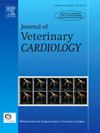Measurement and estimation of normal mitral annular size using computed tomography in 248 small-breed dogs
IF 1.3
2区 农林科学
Q2 VETERINARY SCIENCES
引用次数: 0
Abstract
Introduction/Objectives
Surgical mitral valve repair is gaining recognition as an essential treatment option for dogs with myxomatous mitral valve disease despite the lack of established criteria for suture annuloplasty. Therefore, measuring normal mitral annular size in small-breed dogs without heart abnormalities may help determine the appropriate target annular size.
Animals, Materials and Methods
Dogs weighing <10 kg without evidence of heart disease that underwent three-phase computed tomography (CT) under anesthesia were retrospectively collected. Mitral annular measurements including trigone-to-trigone distance (TT) and the fourth thoracic vertebral body length (T4) were measured using multiplanar reformatting. The correlations between mitral annular measurements and body size, including body weight (BW) and T4, were examined. The regression equations for estimating annular circumference (AC) were then calculated.
Results
The study population comprised 248 dogs weighing 1.2–9.9 kg. Mean values (±standard deviation) of TT and AC were 1.56 (±0.27) and 5.81 (±0.95) cm, respectively. All annular measurements presented a correlation coefficient >0.7 with both BW and T4. Regression equations using BW, T4, and TT explained the AC in our population with sufficient coefficients of determination, with values of 0.68, 0.65, and 0.80, respectively.
Study Limitations
Synchronous electrocardiogram recordings were not available in this study, and the use of electrocardiogram-gated CT may provide a more accurate assessment.
Conclusions
Mitral annular size was strongly correlated with BW and T4 in small-breed dogs. A normal AC can be estimated through regression equations using BW, T4, or TT. The TT calculated using CT images is the most valuable index for accurate estimation.
248只小品种犬正常二尖瓣环大小的计算机断层测量与估计
前言/目的尽管缝合环成形术缺乏既定标准,但外科二尖瓣修复作为二尖瓣黏液瘤病犬的基本治疗选择正得到越来越多的认可。因此,在没有心脏异常的小型犬中测量正常二尖瓣环的大小可能有助于确定合适的目标二尖瓣环大小。动物、材料和方法回顾性收集体重10kg、无心脏疾病的犬在麻醉下行三相计算机断层扫描(CT)。二尖瓣环测量包括三角区至三角区距离(TT)和第四胸椎体长度(T4)采用多平面重构测量。检查二尖瓣环测量与体重(BW)和T4之间的相关性。然后计算了环形周长(AC)的回归方程。结果研究人群包括248只体重1.2-9.9公斤的狗。TT和AC的平均值(±标准差)分别为1.56(±0.27)cm和5.81(±0.95)cm。所有环空测量值与BW和T4的相关系数均为>;0.7。使用BW、T4和TT的回归方程解释了我们人群中的AC,具有足够的决定系数,分别为0.68、0.65和0.80。研究局限性本研究中没有同步心电图记录,使用心电图门控CT可能提供更准确的评估。结论小品种犬二尖瓣环大小与BW、T4密切相关。正常AC可以通过使用BW、T4或TT的回归方程来估计。利用CT图像计算出的TT是准确估计的最有价值的指标。
本文章由计算机程序翻译,如有差异,请以英文原文为准。
求助全文
约1分钟内获得全文
求助全文
来源期刊

Journal of Veterinary Cardiology
VETERINARY SCIENCES-
CiteScore
2.50
自引率
25.00%
发文量
66
审稿时长
154 days
期刊介绍:
The mission of the Journal of Veterinary Cardiology is to publish peer-reviewed reports of the highest quality that promote greater understanding of cardiovascular disease, and enhance the health and well being of animals and humans. The Journal of Veterinary Cardiology publishes original contributions involving research and clinical practice that include prospective and retrospective studies, clinical trials, epidemiology, observational studies, and advances in applied and basic research.
The Journal invites submission of original manuscripts. Specific content areas of interest include heart failure, arrhythmias, congenital heart disease, cardiovascular medicine, surgery, hypertension, health outcomes research, diagnostic imaging, interventional techniques, genetics, molecular cardiology, and cardiovascular pathology, pharmacology, and toxicology.
 求助内容:
求助内容: 应助结果提醒方式:
应助结果提醒方式:


